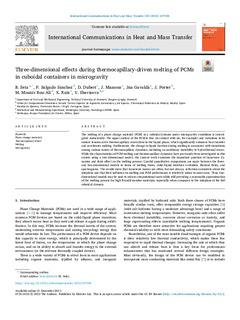Izenburua
Three-dimensional effects during thermocapillary-driven melting of PCMs in cuboidal containers in microgravityEgilea (beste erakunde batekoa)
Argitalpen data
2024Beste erakundeak
IkerbasqueTechnical University of Denmark
Universidad Politécnica de Madrid (UPM)
Universitat Rovira i Virgili
Bertsioa
Bertsio argitaratuaDokumentu-mota
ArtikuluaArtikuluaHizkuntza
IngelesaEskubideak
© 2023 The AuthorsSarbidea
Sarbide irekiaArgitaratzailearen bertsioa
https://doi.org/10.1016/j.icheatmasstransfer.2023.107198Non argitaratua
International Communications in Heat and Mass Transfer Argitaratzailea
ElsevierGako-hitzak
Phase change materialsThermocapillary effect
melting
Microgravity
Laburpena
The melting of a phase change material (PCM) in a cuboidal domain under microgravity conditions is investigated numerically. The upper surface of the PCM is free (in contact with air, for example) and ... [+]
The melting of a phase change material (PCM) in a cuboidal domain under microgravity conditions is investigated numerically. The upper surface of the PCM is free (in contact with air, for example) and variations in its surface tension drive thermocapillary convection in the liquid phase, which significantly enhances heat transfer and accelerates melting. Furthermore, the change in liquid fraction during melting is associated with transitions among various modes of thermocapillary dynamics, including an oscillatory instability to hydrothermal waves. While the characteristics of PCM melting and thermocapillary dynamics have previously been investigated in this system using a two-dimensional model, the current work examines the important question of transverse dynamics and their effect on the melting process. Careful quantitative comparisons are made between the three- and two-dimensional models in terms of melting times, solid/liquid interface evolution, thermal fields, and spectrograms. The results show that transverse modes are often, but not always, reflection symmetric about the midplane and that their influence on melting and PCM performance is relatively minor in most cases. Thus, two-dimensional models may be used to reduce computational costs while still providing a reasonable approximation of the melting process for high Prandtl number materials, especially when compared to the midplane of the full cuboidal domain. [-]
Bildumak
Item honek honako baimen-fitxategi hauek dauzka asoziatuta:






















